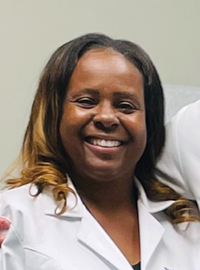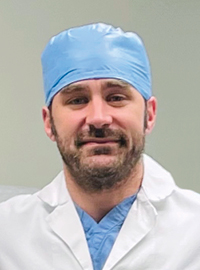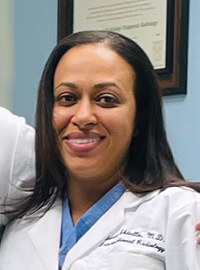(left to right) Tamica D’Aguiar, Neil Harrison, and Sarah Abdulla
At Pennsylvania Hospital, a typical interventional radiology (IR) procedure would be conducted as follows: a department would refer an eligible patient for IR treatment, the IR team would meet briefly with the patient to set procedure expectations and to perform the procedure, and the referring provider would continue as the primary point of contact for the patient’s care plan. While the IR team had little patient interaction in this structure, a new clinic has now allowed the team to engage in fully comprehensive care at the hospital.
Opened in spring 2022, the IR Outpatient Clinic at PAH supports patients eligible for minimally invasive image-guided procedures throughout the course of their clinical journey, from referral to recovery. The clinic, located on the second floor of the Cathcart building, treats a variety of conditions, such as deep vein thrombosis, fibroids, and certain cancers, all led by a team of three providers.
Meet the team behind the outpatient clinic below.
 Tamica D’Aguiar, MSN, CRNP
Tamica D’Aguiar, MSN, CRNP
When a patient is referred to the clinic from another department, nurse practitioner D’Aguiar is their first point of contact. Before a patient arrives, D’Aguiar reviews their chart and evaluates their health records and medical history.
“We put a picture together before we see a patient to see if they would be a good candidate for a procedure,” said D’Aguiar. “From there, we’re with them every step of the way in their clinical care.”
D’Aguiar welcomes patients at the clinic’s entrance and completes a physical examination, walking them through the expectations for a procedure. She’ll check in with the patient in the preoperative area prior to a procedure and meet with them at follow-up appointments. To make care more accessible, D’Aguiar also carries an outpatient phone — a clinical support line for patients to call if they have any questions in their recovery.
“There have been times when, for example, a patient will go home with a biliary drain (an external bag collecting excess bile from the liver), and that could initially be uncomfortable and unfamiliar to live with,” said D’Aguiar. “Patients can call anytime and I will be their support system.”
One of the most rewarding procedures D’Aguiar assists with are uterine fibroid embolizations, a procedure to shrink noncancerous tumors in the uterus. “Many patients come in and they’re suffering with heavy bleeding, and they’re unaware that this procedure exists,” said D’Aguiar. “It’s satisfying when I see them for follow-up appointments and they’re no longer in pain.”
 Neil Harrison, MD
Neil Harrison, MD
Prior to PAH, Harrison was an engineer at a medical device company. He enjoyed working closely with cardiologists to help manage pacemakers and defibrillators for their patients, which inspired his own path to medicine. In his medical education, he served as an intern at PAH in 2014, returning in 2021 as his current role as an attending IR physician.
In this role, and as an assistant professor of Clinical Radiology, Harrison is able to collaborate with peers on a hospital-wide level, connecting with different departments when being referred patients. He finds the most joy in his work through establishing close patient connections, thanks to the new outpatient clinic.
“Our clinic is easily accessible, which I think patients appreciate,” said Harrison. “They’re really relying on you for help, and it’s gratifying when they say that you changed their life.”
Harrison recalls one patient who had a nephrostomy tube (an external bag that drains urine from the kidney) and experienced discomfort when trying to navigate his daily routine outside of the hospital with the tube. For this patient’s particular condition, they had the ability to have it replaced with an internal ureteral stent, not visible outside of the body.
Harrison shared, “Whenever the patient comes in to have his stent replaced, he always says how thankful he is and how much this change has improved his quality of life.”
 Sarah Abdulla, MD
Sarah Abdulla, MD
Abdulla has returned to PAH after serving as an intern at the hospital nearly 10 years ago. As section chief of IR, she schedules and performs procedures, treating a wide gamut of conditions.
“If a patient isn’t a surgical candidate, IR can offer alternatives for treatment,” said Abdulla. “There are no big incisions; We use thin needles, wires, and catheters to help alleviate any pain.”
For one patient who was ineligible for surgery, Abdulla performed an embolization to treat their hemarthrosis (bleeding into a joint). The patient had turned to other providers prior to PAH, but found no solution to the debilitating pain they were experiencing. At the IR clinic, Abdulla treated the bleeding area and offered long-term relief.
Abdulla is also interested in collaborating with other departments to expand care at the clinic, particularly in knee embolization (pain relief by reducing the blood flow to the knee). A relatively novel procedure, knee embolization has only become popular in recent years, Abdulla explained.
“It’s a growing area that hasn’t really been utilized at PAH. It can serve as a precursor for patients who want to delay surgery, or in some cases an alternative to surgery, to decrease knee pain,” said Abdulla. “We hope to work with Orthopaedics to raise more awareness about this offering to patients.”
Besides expansion of services at PAH, Abdulla would like to expand IR services worldwide, creating more global health opportunities for the team. As a medical student at the Perelman School of Medicine, she traveled to Botswana through the Botswana-UPenn Partnership for clinical care. She hopes to develop an IR-based clinical partnership with the program in the future.
“We have so many ideas for the future of IR at PAH,” said Abdulla. “We’re starting with simple baby steps, but we look forward to seeing the clinic grow.”